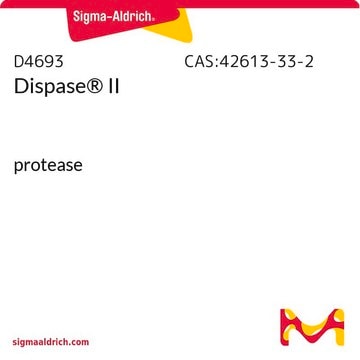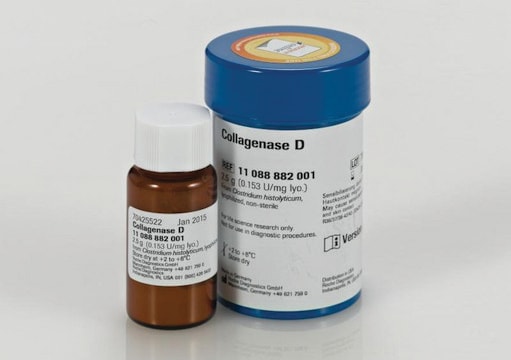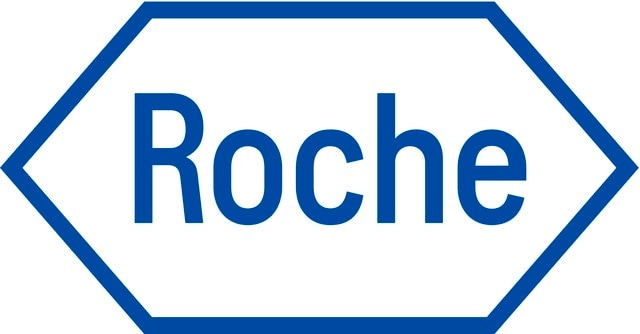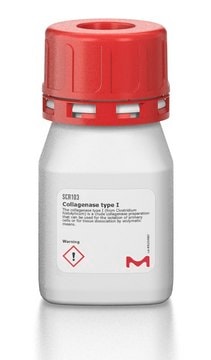추천 제품
생물학적 소스
bacterial
Quality Level
무균
non-sterile
양식
lyophilized
특이 활성도
≥0.8 units/mg protein (37 °C, casein as substrate, pH 7.5)
포장
pkg of 5 × 1 g
제조업체/상표
Roche
최적 pH
6.0-8.5
응용 분야
sample preparation
일반 설명
특이성
애플리케이션
특징 및 장점
- Rapid, effective, yet gentle agent that liberates cells with minimal cell damage
- Maintains cell membrane integrity
- Non-mammalian source - free of mycoplasma and animal virus contamination
- Extremely stable to influences of temperature, pH, and interference by serum components
- Easily inactivated by chelating agents or by dilution
- Delivers higher activity and convenience
단위 정의
A practical comparison of Roche units of Dispase® II with those cited in the Japanese literature (where Dispase® concentrations of 1,000 to 2,000 units/ml are not uncommon) suggests that one Roche unit equals approximately 600 Japanese units of dispase.
One unit of Roche Applied Science Dispase® equals 181 protease units (PU) measured as release of amino acids equivalent to 1 μg tyrosine per min and ml at pH 7.5 and +37 °C.
제조 메모
Inhibitors: EDTA, EGTA, Hg2+, other heavy metals. Dispase is not inhibited by serum.
Working concentration: 0.6 to 2.4 U/ml
Working solution: Preparation of stock and working solutions:
To produce a 10 mg/ml stock solution, dissolve the lyophilized Dispase® II enzyme in HEPES-buffered saline (50 mM HEPES/KOH pH 7.4, 150 mM NaCl). To produce the working solution, dilute the above stock solution with the culture medium for the isolated cells, at a final concentration of 0.6 to 2.4 U/ml. Note that concentrations higher than 2.4 U/ml are not recommended. For best results, filter the working solution using a 0.22 μm filter membrane.
Storage conditions (working solution): -15 to -25 °C
The reconstituted stock solution is stable at 2 to 8 °C for 2 weeks. For storage up to 2 months the stock solution should be frozen in aliquots. Avoid repeated freezing and thawing! The working solution diluted with PBS is stable at 2 to 8 °C for 3 days.
저장 및 안정성
기타 정보
법적 정보
신호어
Danger
유해 및 위험 성명서
Hazard Classifications
Eye Irrit. 2 - Resp. Sens. 1 - Skin Irrit. 2 - STOT SE 3
표적 기관
Respiratory system
Storage Class Code
11 - Combustible Solids
WGK
WGK 1
Flash Point (°F)
does not flash
Flash Point (°C)
does not flash
이미 열람한 고객
문서
Enzyme Explorer Key Resource: Collagenase Guide.Collagenases, enzymes that break down the native collagen that holds animal tissues together, are made by a variety of microorganisms and by many different animal cells.
관련 콘텐츠
Collagenase Guide.Collagenases, enzymes that break down the native collagen that holds animal tissues together, are made by a variety of microorganisms and by many different animal cells.
자사의 과학자팀은 생명 과학, 재료 과학, 화학 합성, 크로마토그래피, 분석 및 기타 많은 영역을 포함한 모든 과학 분야에 경험이 있습니다..
고객지원팀으로 연락바랍니다.











